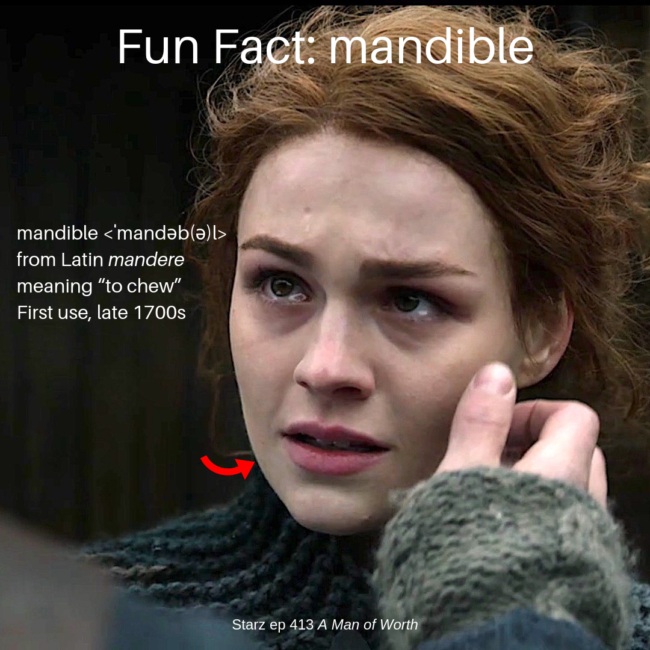 Anatomy Def: The lower jaw or jawbone
Anatomy Def: The lower jaw or jawbone
Outlander Def: That glorious, heartfelt moment when Jamie’s fingers tenderly graze Bree’s jaw.
Learn about the mandible in Anatomy Lesson #26, Jamie’s Chin – Manly Mentus.
The mandible is the largest, strongest and lowest bone of the human face. In the best scenario, it anchors 16 lower teeth (or fewer if the scenario is not that great). <g> Ignoring three tiny ossicles of each middle ear, the mandible is the only movable bone in the adult human skull.
The mandible has U-shaped body which begins center-front at the chin. The body extends backwards on each side to end at right and left angles. The mandible then juts upward from each angle as hearty slabs of bone, the right and left rami (pl.). Each ramus ends in a head which articulates with each temporal bone at the temporomandibular joint (TMJ).
During fetal life, the mandible consists of right and left halves but these fuse into a single bone about the second year after birth. A vertical bony ridge (mandibular symphysis) in the midline is evidence of this union.
About 20% of all facial injuries include a fracture of the mandible which is often accompanied by a “twin fracture” on the opposite side. Metal plates are often used to secure the bony bits during healing.
Try This: Find the point of your chin (mentus). Now place fingers between chin and lower lip. Move fingers back and forth. Feel the bony ridge? This is the mandubular symphysis where two mandibular bones fused early in life. Now, run fingers back along one edge of your jaw to a bony knob just below the ear; this is the angle of the mandible. Now, move fingers upwards along the back of the angle and feel a thick ridge of bone; this is the mandibular ramus. The mandible has an angle and a ramus on each side. Good work, students!
Fun Facts:
- This year marks the 44th anniversary of Stephen Spielberg’s film, Jaws!!! 😳
- The mandible of a blue whale may reach 80 ft. (24 m.) in length!
- Some indigenous Americans once made weapons from elk, bear, buffalo and horse mandibles.
- The quijada or charrasgais is a traditional Latin American percussion instrument made from the jawbone of a mule, horse, or donkey.
- Winston Churchill is credited with the observation: “To jaw-jaw always is better than to war-war.” In other words, a meeting of the minds is preferable to a crushing of the bodies.
Read about the mandible in Diana’s 4th tome, Drums of Autumn. This from the heart-rending first meeting between Jamie and his grown daughter, Brianna.
“Och, no, lassie!” he exclaimed. “I didna mean it that way, at all! It’s only—” He broke off, staring at her in fascination. His hand lifted, as though despite himself, and traced the air, outlining her cheek, her jaw and neck and shoulder, afraid to touch her directly….
He did touch her then, his fingers drawing lightly down her face, brushing back the waves of ruddy hair from temple and ear, tracing the delicate line of her jaw. She shivered again, though his touch was noticeably warm; she could feel the heat of his palm against her cheek.
See Jamie tenderly brush Bree’s jaw in Starz ep. 409, The Birds and The Bees. Sob!!!
A deeply grateful,
Outlander Anatomist
Photo credit: Starz
